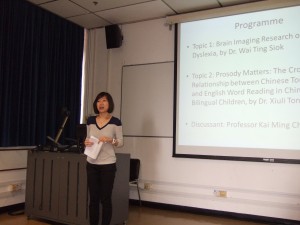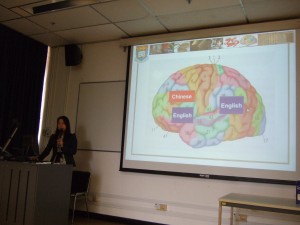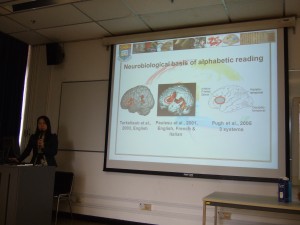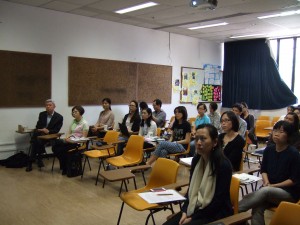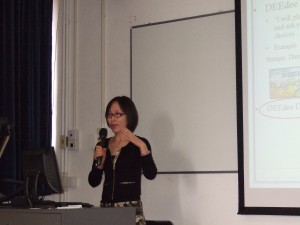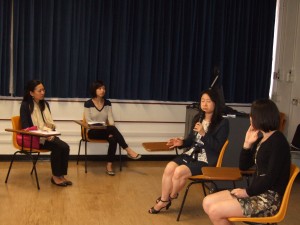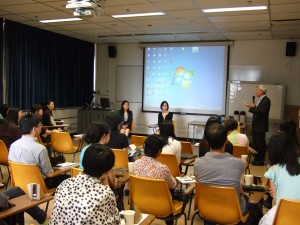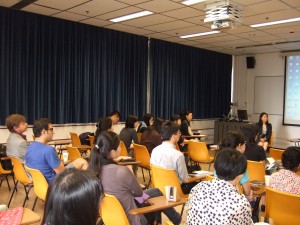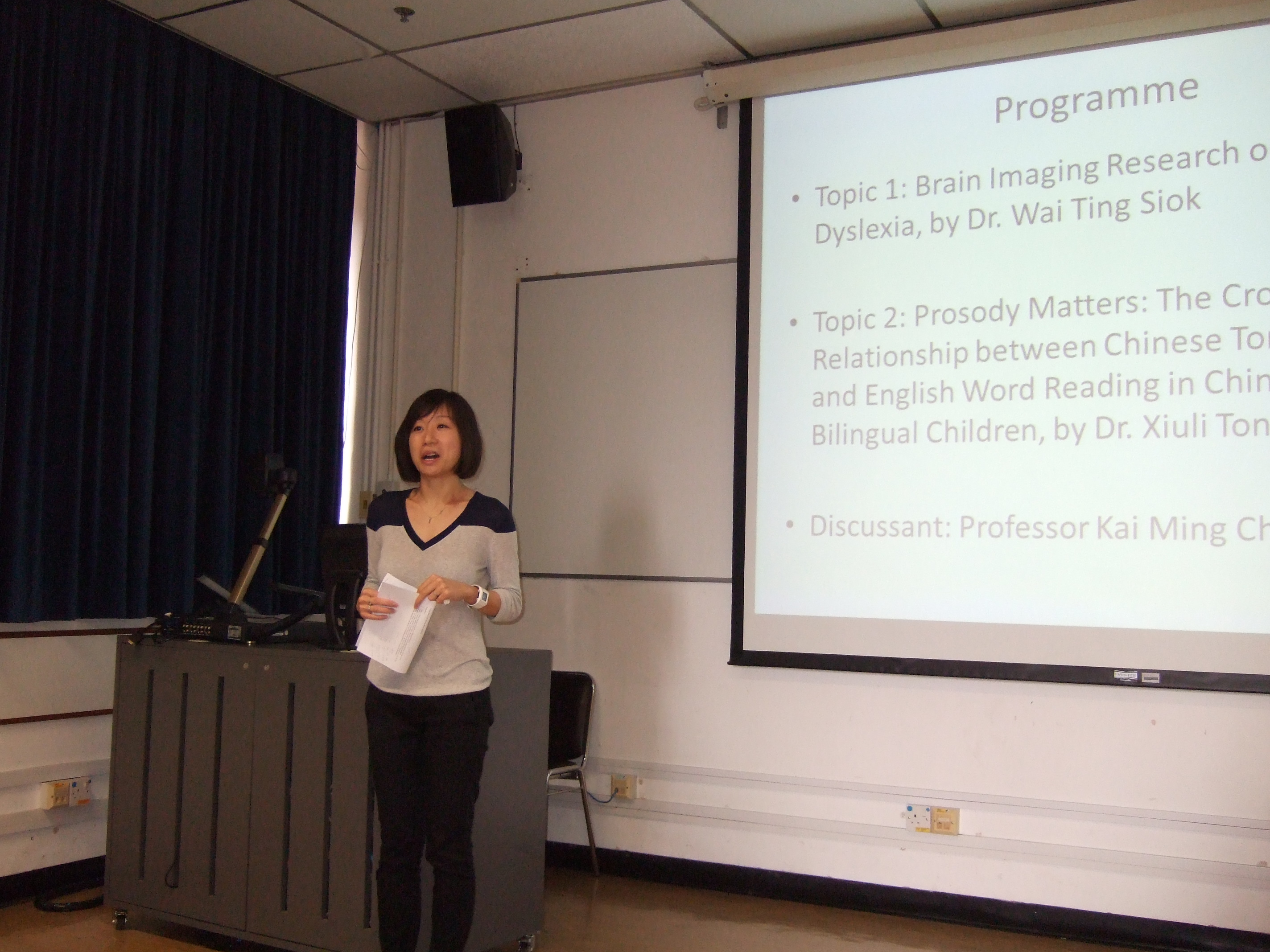Tag Archives: Neuroimaging
Different approaches to language and education research
Date: 14th May, 2014
Time: 12:30 to 14:00
Venue: Runme Shaw Building 205
Speakers: Dr. Wai Ting Siok, Dr Shelley Xuili Tong, Professor Kai Ming Cheng (Discussant)
Program
- Topic 1: Brain Imaging Research on Chinese Dyslexia
- Topic 2: Prosody Matters: The Cross-Linguistic Relationship between Chinese Tone Sensitivity and English Word Reading in Chinese-English Bilingual Children
- Professor Kai Ming Cheng, Chair Professor at the Faculty of Education, will be the discussant, sharing his experience of conducting qualitative research in education.
Introduction:
In the Social Sciences and Education, there has been a debate over research paradigms. There used to be a dichotomy of positivist and interpretive paradigms, but research adopting mixed-methods or critical perspective has been emerging. These various research paradigms have different epistemological orientation and are usually associated with different research methodologies, thereby offering different insights into the same problem. This brown bag seminar brings together three scholars who investigate education and language learning using distinct approaches. A dialogue among these scholars will provide interesting insights into interdisciplinary research in education and Science of Learning.
Topic 1: Brain Imaging Research on Chinese Dyslexia
By Dr. Wai Ting Siok, Department of Linguistics, Faculty of Arts
Abstract
Developmental dyslexia is a neurological condition that is characterized by inaccurate, slow and effortful reading in people who have normal intelligence and schooling. For readers of alphabetic (e.g. English) languages, developmental dyslexia is associated with a core phonological processing deficit which usually does not co-exist with a visual processing dysfunction. Neuroimaging studies have demonstrated that this phonological deficit is typically associated with weak reading-related activity in left temporoparietal regions, and the reduced neural activity is likely a consequence of reduced gray matter volume in these brain areas.
Chinese as a logographic writing system presents a sharp contrast with alphabetic writing systems. Chinese characters map onto the morpheme (meaning) and a monosyllable and cannot be pronounced by recourse to grapheme-phoneme correspondence rules. In a series of fMRI experiments, we scanned Chinese dyslexics while they performed various reading-related tasks including homophone decision, rhyme judgment, physical size decision and semantic decision. Two major findings are demonstrated: (1) Although Chinese dyslexic children exhibit a phonological deficit, this deficit is mediated by the left middle frontal gyrus (LMFG) rather than by the left temporoparietal regions. In addition, dyslexic Chinese readers exhibit reduced gray matter volume in a LMFG region, but do not show functional or structural (i.e., gray matter volume) differences from normal-reading subjects in the more posterior brain systems that have been shown to be abnormal in alphabetic-language dyslexics. (2) Developmental dyslexia in Chinese is commonly associated with the co-existence of a visuospatial deficit and a phonological disorder, unlike the majority of English dyslexics. Combined with previous behavioral findings, we conclude that Chinese dyslexia is characterized by multiple problems without a core deficit. Our results suggest that the behavioral and pathophysiological profiles of developmental dyslexia vary across cultures.
About the speaker
Dr. Wai Ting Siok is Associate Professor of Linguistics and Brain and Cognitive Sciences. She received her Ph.D. in Psycholinguistics and Education from the University of Hong Kong. After a two-year postdoctoral training in neuroscience at Stanford University Psychology Department and the Stanford Institute of Reading and Learning, she started to work in the Department of Linguistics of HKU in 2004. Dr. Siok’s research focuses on bilingualism, language development and language neuroscience. Her ongoing research is aimed at determining the behavioral and neural mechanisms that underlie reading in normal and dyslexic children.
Topic 2: Prosody Matters: The Cross-Linguistic Relationship between Chinese Tone Sensitivity and English Word Reading in Chinese-English Bilingual Children
By Dr. Xiuli Tong, Division of Speech and Hearing Sciences, Faculty of Education
Abstract
Prosodic sensitivity is the ability to distinguish phonetic distinctions related to pitch, such as Chinese lexical tone and English lexical stress. Recent evidence shows that there is a cross-linguistic relationship between prosodic sensitivity and English word reading for Chinese-English bilinguals. The present study tests two theoretical hypotheses proposed to explain these findings. A group of 188 Chinese-English bilingual children of 7 to 8 years of age completed multiple measures of Chinese tone sensitivity, English stress sensitivity, and segmental phonological awareness in Chinese and English, as well as measures of English vocabulary and English word reading. Structural equation modeling analyses revealed that Chinese tone sensitivity significantly predicted English stress sensitivity, and that English stress sensitivity, in turn, significantly predicted English word reading, even after taking into account Chinese and English segmental phonological awareness and vocabulary. In contrast, the relationship between Chinese tone sensitivity and English word reading did not appear to be mediated through either Chinese or English segmental phonological awareness. Together, these results accord with the prosody hypothesis, suggesting that English stress sensitivity mediates the relation between Chinese tone sensitivity and English word reading for Chinese-English bilingual children.
About the speaker
Dr. Shelley Xuili Tong is Assistant Professor in the Division of Speech and Hearing Sciences at the University of Hong Kong. She received her Ph.D in Developmental Psychology from the Chinese University of Hong Kong. She completed two postdoctoral fellowships: one at Dalhousie University in English reading comprehension difficulties and English compensated adult dyslexics, and the second in bilingual speech perception in MARCS Institute at the University of Western Sydney. She started to work in the Division of Speech and Hearing Sciences of HKU in 2011. In the same year, she was awarded the U.S National Academy of Education/Spencer Postdoctoral Fellow. Her research interests include biliteracy acquisition, bilingual speech perception, statistical learning, reading comprehension difficulties in Chinese and English. Her current research effort is on a cross-country, cross-language study exploring the nature of reading comprehension difficulties in Chinese and English.